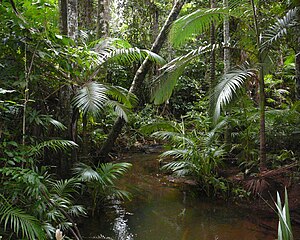Archontophoenix alexandrae
| Archontophoenix alexandrae | |
|---|---|

| |
| Scientific classification | |
| Kingdom: | Plantae |
| Clade: | Tracheophytes |
| Clade: | Angiosperms |
| Clade: | Monocots |
| Clade: | Commelinids |
| Order: | Arecales |
| Family: | Arecaceae |
| Genus: | Archontophoenix |
| Species: | A. alexandrae
|
| Binomial name | |
| Archontophoenix alexandrae | |
| Synonyms[3] | |
| |
Archontophoenix alexandrae, commonly known as Alexandra palm, king palm, northern Bangalow palm, or feather palm,
Description
Archontophoenix alexandrae is a tall, solitary palm growing to a height of 30 m (98 ft) with a trunk up to 30 cm (12 in) diameter, often swollen at the base, and bearing prominent leaf scars.
Flowers

The
Fruit
The fruits are ovoid to globose with a persistent calyx. They are initially green turning bright red when ripe. They measure around 10–14 mm (0.4–0.6 in) in diameter and contain a single seed about 8 mm (0.3 in) diameter.[4][7]
Taxonomy
The species was originally described as Ptychosperma alexandrae by Ferdinand von Mueller in his Fragmenta phytographiae Australiae in 1865.[8] In 1875 the German botanists Hermann Wendland and Oscar Drude published a treatment of Australian palms in the journal Linnaea titled Palmae Australasicae, in which this species was renamed Archontophoenix alexandrae.[9]
Etymology
The genus name is derived from the Ancient Greek ἄρχων (árkhōn), meaning "chieftain" or "ruler", combined with the palm genus Phoenix, and refers to the regal stature of the trees. The species epithet is given in honour of Princess Alexandra of Denmark.[7][10]
Distribution and habitat

The native range of this species is north-east and central-east Queensland, from the Melville Range in Cape York Peninsula to south of Gladstone.[5][7] The altitudinal range is from sea level to 1,000 m (3,300 ft), although it is most commonly found in lowland riparian rainforest alongside river courses and swamps, often in locations that are severely inundated during heavy rain events.[4][7] Their ability to withstand these conditions allows them to become the dominant species.
Ecology
The fruit of the Alexandra palm is eaten by many bird species,
Uses
The Kuku Yalanji people of Far North Queensland ate the palm heart of this species.[11]
Cultivation
This species is easily grown from fresh seed, and is very popular in cultivation in Australia, both for private gardens and as a street and park tree.[4][12] It is fast growing and will tolerate cooler climates outside the tropics where there are no frosts, and has been widely planted in many countries. It has become naturalised in Hawaii.[13]
Gallery
-
Habitat
-
Flowering
-
Fruiting
-
Fruit
See also
References
- . Retrieved 2 August 2022.
- ^ "Species profile—Archontophoenix alexandrae (Alexandra palm)". Queensland Department of Environment and Science. Queensland Government. Retrieved 2 August 2022.
- ^ a b "Archontophoenix alexandrae (F.Muell.) H.Wendl. & Drude". Plants of the World Online. Royal Botanic Gardens, Kew. Retrieved 17 March 2021.
- ^ Commonwealth Scientific and Industrial Research Organisation(CSIRO). Retrieved 17 March 2021.
- ^ a b c d e "Archontophoenix alexandrae". Palm and Cycad Society of Australia. Retrieved 17 March 2021.
- Cairns Regional Council. Archived from the original(PDF) on 25 April 2018. Retrieved 17 March 2021.
- ^ ISBN 9780958174213. Retrieved 17 March 2021.
- ^ "Ptychosperma alexandrae F.Muell". Plants of the World Online. Royal Botanic Gardens, Kew. Retrieved 15 March 2021.
- ^ "Archontophoenix alexandrae var. schizanthera H.Wendl. & Drude". Plants of the World Online. Royal Botanic Gardens, Kew. Retrieved 15 March 2021.
- ^ "Archontophoenix H.Wendl. & Drude, Linnaea 39: 182 (1875)". PalmWeb. Retrieved 3 August 2022.
- ISBN 0-646-22991-5.
- ISBN 0-7301-0381-1.
- ^ "Archontophoenix alexandrae" (PDF). Hawaiian Ecosystems at Risk project (HEAR). Retrieved 21 March 2021.
External links
- Map of occurrences of Archontophoenix alexandrae at the Atlas of Living Australia
- See images of Archontophoenix alexandrae on Flickriver
- View observations of this species on iNaturalist





